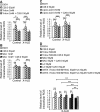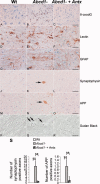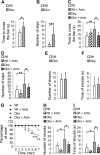Antioxidants halt axonal degeneration in a mouse model of X-adrenoleukodystrophy
- PMID: 21786300
- PMCID: PMC3229843
- DOI: 10.1002/ana.22363
Antioxidants halt axonal degeneration in a mouse model of X-adrenoleukodystrophy
Abstract
Objective: Axonal degeneration is a main contributor to disability in progressive neurodegenerative diseases in which oxidative stress is often identified as a pathogenic factor. We aim to demonstrate that antioxidants are able to improve axonal degeneration and locomotor deficits in a mouse model of X-adrenoleukodystrophy (X-ALD).
Methods: X-ALD is a lethal disease caused by loss of function of the ABCD1 peroxisomal transporter of very long chain fatty acids (VLCFA). The mouse model for X-ALD exhibits a late onset neurological phenotype with locomotor disability and axonal degeneration in spinal cord resembling the most common phenotype of the disease, adrenomyeloneuropathy (X-AMN). Recently, we identified oxidative damage as an early event in life, and the excess of VLCFA as a generator of radical oxygen species (ROS) and oxidative damage to proteins in X-ALD.
Results: Here, we prove the capability of the antioxidants N-acetyl-cysteine, α-lipoic acid, and α-tocopherol to scavenge VLCFA-dependent ROS generation in vitro. Furthermore, in a preclinical setting, the cocktail of the 3 compounds reversed: (1) oxidative stress and lesions to proteins, (2) immunohistological signs of axonal degeneration, and (3) locomotor impairment in bar cross and treadmill tests.
Interpretation: We have established a direct link between oxidative stress and axonal damage in a mouse model of neurodegenerative disease. This conceptual proof of oxidative stress as a major disease-driving factor in X-AMN warrants translation into clinical trials for X-AMN, and invites assessment of antioxidant strategies in axonopathies in which oxidative damage might be a contributing factor.
Copyright © 2011 American Neurological Association.
Figures




References
-
- Lin MT, Beal MF. Mitochondrial dysfunction and oxidative stress in neurodegenerative diseases. Nature. 2006;443:787–795. - PubMed
-
- Pratico D. Evidence of oxidative stress in Alzheimer's disease brain and antioxidant therapy: lights and shadows. Ann N Y Acad Sci. 2008;1147:70–78. - PubMed
-
- Stack EC, Matson WR, Ferrante RJ. Evidence of oxidant damage in Huntington's disease: translational strategies using antioxidants. Ann N Y Acad Sci. 2008;1147:79–92. - PubMed
Publication types
MeSH terms
Substances
LinkOut - more resources
Full Text Sources
Other Literature Sources
Medical
Molecular Biology Databases

